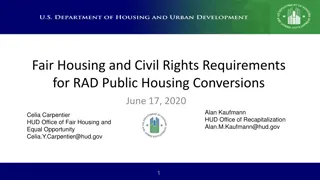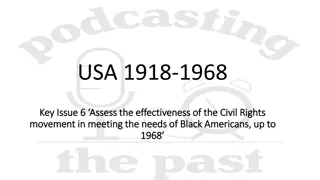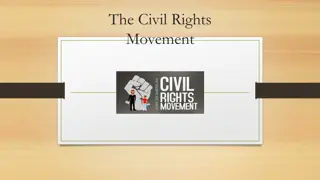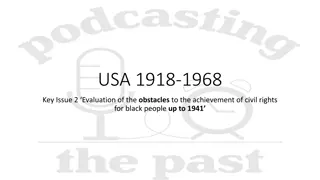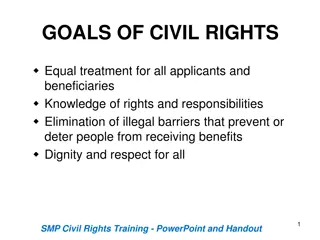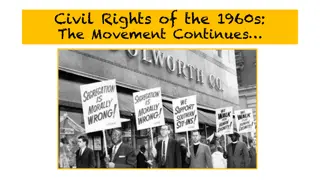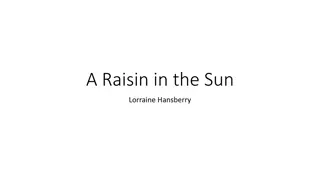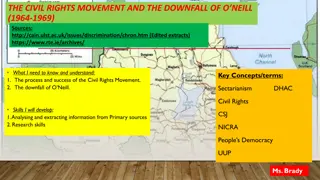Life of Lorraine Hansberry: From Childhood to the Civil Rights Movement
Delve into the life of Lorraine Hansberry, a significant figure during the civil rights movement. Explore her upbringing in Chicago, her father's impactful actions challenging segregation, and the setting of her renowned play "A Raisin in the Sun" amidst civil rights struggles.
Download Presentation

Please find below an Image/Link to download the presentation.
The content on the website is provided AS IS for your information and personal use only. It may not be sold, licensed, or shared on other websites without obtaining consent from the author. Download presentation by click this link. If you encounter any issues during the download, it is possible that the publisher has removed the file from their server.
E N D
Presentation Transcript
Lorraine Hansberry
CHILDHOOD Lorraine Hansberry was born on May 19, 1930, and she was the youngest of four children. She enjoyed a comfortable middle class existence.
CHILDHOOD She lived in South Side Chicago and grew up knowing some of the greatest African Americans of her time, like Langston Hughes, Duke Ellington, Joe Lewis, and her mentor, W.E.B. Du Bois.
TURNING POINT In 1938, Hansberry s father, Carl, challenged the segregated housing pattern in Chicago when he purchased a house in an all- white neighborhood.
TURNING POINT The family was threatened by a white mob and forced to leave by a court order. Carl Hansberry took the case to the Supreme Court where he won a favorable judgment in 1940 (Hansberry vs Lee).
TURNING POINT Despite the victory, the experience left Carl Hansberry bitter and disillusioned, something Lorraine Hansberry would not forget.
CIVIL RIGHTS MOVEMENT The play A Raisin in the Sun is set during the 1950 s. This was a pivotal time during the civil rights movement. During this time period, it was legal to discriminate against people based on race or sex, in terms of employment, education, and public accommodations.
GREAT NORTHERN MIGRATION During this time, many African Americans continued to leave the South and settle in the Northern United States Chicago was one of the cities that grew most from southern black immigration. Between 1940 and 1950, the number of African Americans living in Chicago grew by 80%. The number of whites grew by .1%.
CITY LIFE Many of the African-Americans living in Chicago were living in run-down neighborhoods which became all-black public housing projects. Most units were overcrowded and shared bathroom facilities between multiple families.
EMPLOYMENT Jobs were increasingly hard to find for both black men and women after WWII. Many women worked as domestic help and the men were working in plants.
IMPORTANT DATES FROM THE 1950S
1954 Brown v. Board of Education outlawed segregated public schools; however, it was left to local officials to decide when they d like to start desegregating.
1955-1956 1955-1956-Montgomery Bus Boycott
1957 Martin Luther King formed the Southern Christian Leadership Conference. Their goal was to form an organization to coordinate and support non- violent action as a method of desegregating bus systems across the South. Before long, they began focusing not just on bussing, but on all forms of segregation.
1957 Southern leaders begin a movement called Massive Resistance , an effort to resist desegregation in schools. Specifically, the governor of Arkansas refused to let nine black students enter a local high school. The U.S. Army was called to escort and protect the nine students.
THE AMERICAN DREAM The play s introduction asks, What happens to a dream deferred? This establishes the major theme. To defer means to put off. For the most part, the dreams of the major characters have been put on hold for a long time, but, ironically, when the chance for their dreams to come true does arrive, it creates conflict. Ultimately the characters do find out that dreams can come true, but not always with ease.
THE POWER OF PREJUDICE Set in Chicago in the 1950 s, before the rise of the civil rights movement, A Raisin in the Sun reveals a social undercurrent of racial tension. The main characters know discrimination; in large part it is the reason their dreams have been deferred. Prejudice, in an all-white community, is an underlying theme that sets the tone for the play, as well as the time period in which it takes place.

 undefined
undefined


 undefined
undefined





